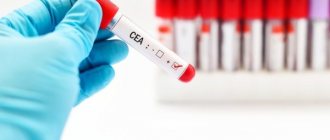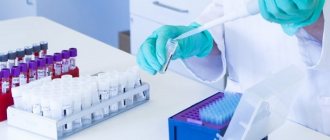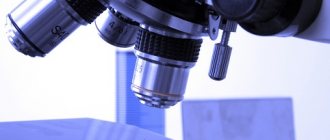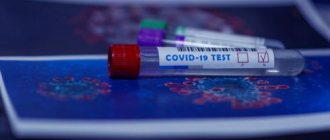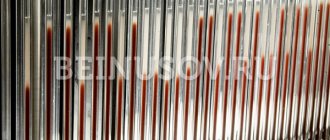SCC (Squamous cell carcinoma antigen) is a tumor marker for squamous cell carcinoma. It can develop anywhere where there is squamous epithelium. This could be the cervix, oral cavity, esophagus, head and neck organs, skin, anus, and even the lungs.
- Types of tumor marker SCC
- Indications for analysis
- When is it necessary to take an SCC test?
- Deciphering the SCC tumor marker for squamous cell carcinoma of the cervix
- Decoding the analysis results
- Advantages and disadvantages of SCC analysis (reliability of the study)
- The importance of diagnosing the disease at an early stage
SCC is present in squamous epithelium normally and is responsible for its differentiation. With the development of cancer, there is an increase in its production by malignant cells. It is believed that it slows down the process of apoptosis (programmed cell death), which leads to their uncontrolled growth, reproduction and metastasis.
Indications for analysis
Tests for the SCC tumor marker are prescribed in the following cases:
- Comprehensive examination for squamous cell carcinoma. The level of this marker correlates well with the stage of the disease, the depth of tumor invasion, and the likelihood of metastases.
- Treatment planning for patients with an already established diagnosis. In general, the higher the SCC marker level, the more aggressive treatment is required.
- Monitoring treatment for squamous cell carcinoma. The half-life of the SCC tumor marker does not exceed 1 hour, therefore, with radical treatment, its level should decrease to the reference range within several days. If it remains unchanged, then the treatment is ineffective and it is necessary to reconsider its regimen. If the SCC concentration decreases to normal, this indicates the effectiveness of therapy in more than 90% of patients.
- Disease prognosis marker. For example, if in patients with cervical cancer without signs of lymph node involvement, the level of this tumor marker exceeds 1.9 μg/l, then their likelihood of developing a relapse is 3.5 times higher compared to patients in whom the analysis fails outside the reference range.
What tumor markers should women take?
Gynecological cancer kills millions of women every year.
The first symptoms of the disease appear quite early, but women either do not pay attention to them or are embarrassed to see a doctor.
Female tumor markers make it possible to diagnose oncopathology of the female genital organs without additional research methods.
Types of cancer in women
Women have to face cancer of the cervix and uterine body, ovaries and breast.
All women's diseases, which are based on the cancer process, have ten common signs that allow one to suspect oncological pathology in the early stages:
- there is bloody or bloody discharge;
- uterine bleeding (metrorrhagia) appears;
- menstruation becomes painful and irregular (algodysmenorrhea);
- the size of the abdomen changes;
- discharge from the mammary glands begins;
- lumps appear in the mammary glands;
- unmotivated fatigue and increased fatigue appear;
- a woman loses weight;
- bothered by abdominal pain;
- an unexplained fever develops.
Uterine cancer develops due to:
- early onset of sexual activity,
- smoking,
- untreated precancerous diseases, etc.
Women suffer from adenocarcinoma (glandular cancer) of the cervix and cervical canal, as well as squamous cell cancer of the cervix.
Women are rarely diagnosed with uterine sarcoma.
Tumor markers for women are a good help in the early diagnosis of uterine cancer.
Ovarian cancer mainly affects women over fifty years of age.
The peculiarity of this type of cancer is that the first signs of the disease appear when the tumor reaches a large size and puts pressure on surrounding organs.
Women appear
- nagging pain in the lower back,
- severe pain after intercourse and
- signs of anemia.
Determining the level of female tumor markers allows for timely detection of oncological alertness.
The first manifestations of female breast cancer can be detected during examination.
This is a change in the shape of the mammary gland, deformation of the nipple, and the presence of discharge from it.
Changes in the skin in a certain area of the gland (the skin resembles a lemon peel) and the appearance of dense tuberous nodes in the thickness of the mammary gland.
With such symptoms, a woman should immediately consult a doctor and donate blood for tumor markers.
What tumor markers should women take?
The female body produces hormones, the level of which can increase with genital cancer.
In addition, with genital cancer, organ-specific tumor markers appear in a woman’s body, which make it possible to suspect cancer of the uterus or appendages.
If a woman is suspected of having cancer of the internal genital organs, the following tumor markers are determined:
- cancer antigen 125;
- beta human chorionic gonadotropin;
- carcinoma embryonal antigen;
- tumor marker 27-29;
- squamous cell carcinoma marker SCC;
- estradiol
Cancer antigen CA-125
is a glycoprotein that is present in serous membranes and tissues.
The source of CA-125 in women of reproductive age is the endometrium. This is associated with a cyclic change in the concentration of CA-125 in the blood in different phases of the menstrual cycle.
During menstruation, the tumor marker CA-125 is produced in increased quantities.
During pregnancy, the tumor marker CA-125 can be detected in the placenta extract, amniotic fluid (from 16 to 20 weeks) and in the blood serum of the pregnant woman (in the first trimester).
Beta human chorionic gonadotropin
human is produced by the placenta of a pregnant woman. Its β-subunit is of diagnostic value, the concentration of which is used to judge the course of pregnancy. If the level of β-chorionic gonadotropin increases in the blood of a non-pregnant woman, then this clearly indicates a tumor process in her body.
Tumor marker CA 27-29
is the only tumor marker that is considered absolutely organ-specific for the mammary gland.
It is a soluble form of the MUC1 glycoprotein. This glycoprotein is expressed on the cell walls of breast carcinoma. It is produced in excess in endometriosis and female genital cancer.
Tumor marker SCC
is a tumor marker for squamous cell carcinoma. This is a protein that is produced by epithelial cells of the cervix, skin, bronchi, and esophagus.
Estradiol
is a specific marker (estrogen hormone), which is always detected in the blood of both women and men.
The functioning of many organs and systems of the female body depends on its level. Its concentration in the blood increases during pregnancy and many women's diseases. However, a sharp increase in the amount of estradiol may also indicate ovarian cancer.
Indications for testing for tumor markers
Women's health depends on whether it is monitored with cancer cell markers in a timely manner.
Examination of a woman with tumor markers is indicated in the following cases:
- for diagnosing cancer of the genitals and mammary glands;
- for the purpose of screening the radicality of tumor removal during surgery;
- to monitor the effectiveness of ongoing antitumor therapy;
- in order to predict the course of the disease and the likelihood of tumor recurrence.
- in the follicular phase from 68 to 1269 pmol/l;
- the ovulatory peak is in the range of 131-1655 pmol/l;
- in the luteal phase from 91 to 861 pmol/l.
Interpretation of study results for tumor markers and tumor marker norms
Interpretation of the results of analysis for tumor markers should be carried out in the laboratory where the study was performed.
The norm of indicators depends on the analysis technique.
We offer the most accepted interference indicators of tumor marker levels.
Reference values for the tumor marker CA-125 in women in blood serum are up to 35 IU/ml; during pregnancy, its concentration can increase to 100 IU/ml.
The normal hCG level in non-pregnant women is 6.15 mU/L. For non-pregnant women, the free β-subunit of hCG in venous blood is up to 0.013 mIU/ml.
In healthy people, the CEA level rarely exceeds 3 ng/ml, but can sometimes reach 5-10 ng/ml in the case of benign diseases, 7-10 ng/ml in patients suffering from alcoholism and up to 10-20 ng/ml in smokers.
In patients with localized cancer, the concentration of CEA increases in 25% of cases. If women have metastases, the CEA tumor marker will be elevated in 60-80% of cases.
Exorbitant initial concentrations of CEA on the eve of surgical treatment may indicate metastasis of a malignant tumor to regional lymph nodes.
A persistent increase in tumor marker levels indicates that there is no adequate response to therapy.
An increased level of the tumor marker CEA indicates the likelihood of relapse of the disease several months before the appearance of the first clinical signs.
The normal level of breast tumor markers CA 27-29 is less than 38-40 U/ml.
In an adult patient, the concentration of the tumor marker AFP should not exceed 20 ng/ml. Also, a CA level of 27-29 above 10,000 ng/ml may portend an unfavorable outcome of the disease.
The upper limit of normal for the SCC tumor marker (discriminatory level) is 1.5 ng/ml.
The normal concentration of estradiol in a non-pregnant woman is considered to be 40-161 pmol/l.
Its level depends on the phase of the cycle:
In postmenopausal women, estradiol levels should not exceed 73 pmol/l. If this hormone is detected in concentrations exceeding the interference values, one should think about cancer of the female genital organs.
Where can you get tested and how to prepare for them?
Tests for tumor markers can be taken at the Polyclinic of Innovative Technologies LLC.
On the eve of the test, a woman should rest well, stop taking medications and not smoke.
Drinking alcohol is also contraindicated.
You can eat food eight hours before donating blood for testing.
Blood is taken from the cubital vein after the woman has rested for fifteen minutes. It is desirable that she be in a state of complete psychological peace. Analyzes must indicate reference values.
It will also be important for the doctor to know what method was used to conduct the study.
If you are faced with the problem of female cancer pathology, contact your obstetrician-gynecologist immediately.
Diagnosis in the early stages of the disease can be made after determining the level of tumor markers.
Early diagnosis of cancer of the female reproductive system is the key to successful treatment of the disease.
This article is for informational purposes only. An obstetrician-gynecologist at our Polyclinic can tell you in more detail about the prevention of diabetes.
The Polyclinic of Innovative Technologies LLC has developed a special program for the early detection of diseases, including cancer in women
, diagnostics are available to the population of all ages, you MUST undergo it and you will get rid of the “mass” of problems in your body.
In your free time, call him by phone: call center 8 (495) 356 3003.
LLC "Innovative Technologies" thanks you for
that you took the time to read this information.
When is it necessary to take an SCC test?
Tests for SCC are recommended in the following cases:
- When undergoing examination for suspected malignant epithelial neoplasms (cancer). This examination should be prescribed by a doctor, due to the ambiguity in the interpretation of the results.
- When choosing a cancer treatment protocol. The analysis allows us to select a group of patients who are initially indicated for more aggressive treatment.
- At the planning stage of oncological surgery and after it. This will allow you to assess the radicality of surgical treatment.
- After finishing treatment for squamous cell carcinoma. Unfortunately, many types of cancer are prone to recurrence and progression. To detect this in time, it is necessary to undergo regular examinations, including tests for tumor markers.
Treatment of abnormalities
The test for SCC antigen in the blood is in demand in clinical practice as a tool for monitoring patients with an established diagnosis of squamous cell carcinoma. The results are used to assess the course of the disease, early diagnosis of relapses and metastasis, prognosis and treatment tactics. It is worth avoiding independent interpretation of the analysis results, since an isolated value without taking into account data from other studies does not provide enough information about the state of health and cannot serve as evidence of the absence or presence of cancer. During the consultation, the attending physician (oncologist, gynecologist, surgeon, dermatologist) will establish a diagnosis, determine the need for treatment and/or additional examination.
Deciphering the SCC tumor marker for squamous cell carcinoma of the cervix
Increased SCC levels were found in more than half of women with cervical cancer of various stages. At the initial stages, the sensitivity of this test is low, but at stage 4, it is about 80%. After radical surgery to remove the tumor, SCC levels typically decline to normal within 96 hours.
If the test result remains elevated or continues to increase, this indicates the development of a relapse or progression of the pathology. Moreover, in 46-92% of cases, an increase in SCC makes it possible to detect a relapse several months before the development of the clinical picture.
Research method
Glycoprotein protein is determined by the CLIA (Caris Molecular Intelligence) method, based on molecular diagnostics of a malignant tumor sample. This method is effective in selecting an individual treatment regimen, taking into account the duration of the compaction, the specifics of the progression of the pathology, as well as the patient’s health condition.
SCCA decoding is performed by a diagnostician at the laboratory center where the study was conducted. The obtained data is displayed in a special document, which is issued to the patient along with other medical reports.
Decoding the analysis results
The reference values for men and women are the same - 0-1.5 ng/ml. However, we draw attention to the fact that this analysis must be interpreted together with the results of other examination methods.
Most often, an increase in SCC is observed in squamous cell carcinoma of the following localizations:
- Cervix.
- Kidneys and ureters.
- Oral cavity.
- Lungs.
- Anal canal
- Leather.
The following pathologies may be the reasons for a slight increase in SCC levels:
- Skin diseases: psoriasis, eczema, etc.
- Lung diseases: tuberculosis, pneumonia, sarcoidosis.
- Chronic renal or liver failure.
Note! Considering that type 2 SCC is found in large quantities in saliva, sweat and respiratory secretions, when obtaining an increased result, it is necessary to be sure that the samples are not contaminated with these biological fluids.
Preparation for analysis and collection of material
The biomaterial used to perform the SCC antigen test is venous blood. The procedure is usually carried out in the morning, on an empty stomach. If blood is taken during the day, at least 4 hours must pass after eating. The consumption of fatty foods and alcohol should be eliminated one day before. In the last half hour you need to stop smoking and avoid physical and emotional stress. Blood is taken from the cubital vein. Since SCC antigen is contained in skin cells, saliva, sweat, and respiratory tract secretions, special care is required when performing the procedure. Sample contamination leads to false positive results.
After collection, the blood is delivered to the laboratory within several hours. Before the analysis procedure, it is centrifuged, as a result of which the plasma is separated from the blood clot. The clotting factors are then removed from the liquid portion. The resulting serum is subjected to chemiluminescent immunoassay. It is based on the ability of the squamous cell carcinoma antigen to form specific complexes with enzyme-labeled antibodies. After this, the mixture is washed and a chemiluminescent substrate is added to it - a substance that reacts with the enzyme, releasing a non-thermal glow. The photon flux is recorded by a luminometer, and the resulting values serve as the basis for calculating the SCC antigen concentration. Preparation of results depends on the operating hours of the laboratory; on average, it takes up to 5 working days.
Advantages and disadvantages of SCC analysis (reliability of the study)
Like the vast majority of tumor markers, SCC does not have high sensitivity and specificity. This means that not all patients with squamous cell carcinoma will have elevated levels, and not all healthy people will have normal levels.
In addition, tumor marker tests should not be used for preliminary evaluation and screening of squamous cell carcinoma. It is used only as an additional examination method. If its result is elevated, and there is evidence of pathology of a tumor nature, it is necessary to exclude all benign diseases and, if possible, conduct a histological examination of the neoplasm. In other words, the result of this test does not confirm or deny the presence of squamous cell carcinoma.
With an initially high level of SCC against the background of a diagnosed malignant process, it serves as a good marker that can be used as a guide when choosing a treatment method, as well as monitor the patient’s condition and detect progression and relapses in a timely manner.
What real practical applications do S-100, LDH and SCCA have now?
All 3 markers listed can be used for three purposes:
1) Monitoring the progression of the disease - the development of metastases and relapses.
2) Monitoring the response to therapy.
In situations 1) and 2) it is important to know the levels of S-100 and LDH that were before treatment.
3) As individual prognostic factors. Moreover, in the case of melanoma, this is true more for LDH than for S-100. For SCC in squamous cell carcinoma of the skin and mucous membranes, this statement, to put it mildly, has not been proven .
The importance of diagnosing the disease at an early stage
In oncology, diagnosing the disease at an early stage is crucial. If a tumor is detected on time, it is possible not only to save the patient’s life, but also to carry out more gentle, organ-preserving treatment.
FGM seriously affects a person's quality of life. Firstly, they can lead to the development of severe complications. For example, during extensive operations to treat cervical cancer, a woman loses her uterus and, accordingly, the ability to independently carry and give birth to a child. Removal of the pelvic lymph nodes can lead to the development of elephantiasis of the limb and profound disability of the patient. Removal of the ovaries inevitably leads to menopause. Against this background, depression of mood, apathy and even depression often develop. All this torment can be avoided with timely diagnosis and treatment of precancerous diseases. It is enough just to carry out tests for cervical cancer screening in a timely manner.
Book a consultation 24 hours a day
+7+7+78
What is S-100?
S-100 is a protein, or rather a whole family of proteins that are involved in a wide variety of processes in the body. It is these that melanoma cells can release into the blood. And it is their level that can be measured, on the basis of which assumptions can be made about the diagnosis of melanoma.
Unfortunately, the level of this protein can be increased not only in melanoma, but also in other tumors - breast cancer, ovarian cancer, stomach cancer, prostate cancer and some others.
Another feature you need to know: S-100 levels can increase in rheumatoid arthritis, subarachnoid hemorrhage, acute myocardial ischemia, psoriasis, etc.
Which test is most accurate for diagnosing melanoma and skin cancer?
The most accurate diagnostic test for suspected melanoma and skin cancer is an excisional biopsy (complete removal) of the entire formation, including 1–3 mm of healthy skin, followed by histological examination. In some cases, it is possible to remove a fragment ( incisional biopsy ) of a suspicious formation, capturing the thickest part, also with histology.
Please note - this is not my opinion. This is the opinion of the major oncology associations NCCN and ESMO. There is not a word about any cytological examination of scrapings, punctures of moles or dermatoscopy in their practical recommendations - these are auxiliary preliminary tests.
What to do if you have tested the tumor markers S-100, SCC and they are positive?
Unfortunately, you will need to undergo a fairly in-depth examination, otherwise you will most likely not be able to relax. A FULL examination of all skin by an oncologist-dermatologist is required, including dermatoscopy of all moles on the body, clinical and biochemical tests of blood, urine, ultrasound of the abdominal cavity and all groups of lymph nodes, pelvis, and chest x-ray.

If positive tumor markers are detected, a full diagnosis will be required
